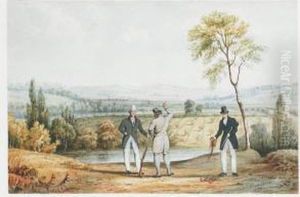Thomas J. Rawlins Paintings
Thomas J. Rawlins was an English medalist and playwright who lived during the 17th century. Born in 1620, Rawlins' early life and education remain somewhat obscure, but it is known that he became an apprentice to the prominent London goldsmith, Thomas Rawlins, who was likely his father. His career spanned a tumultuous period in English history that included the English Civil War, the Interregnum, and the Restoration of the monarchy.
Rawlins' contributions to the art of medal-making are significant, as he was one of the few notable English artists in this medium during his time. He produced medals that often bore political significance, reflecting the shifting allegiances and turbulent events of the era. His works include both cast and struck medals, and he is known for a small number of portrait medals, which are considered rare and valuable by collectors and historians.
In addition to his work as a medalist, Thomas Rawlins is remembered for his involvement in the dramatic arts. He wrote several plays, the most famous being 'The Rebellion,' a tragi-comedy that was first staged in 1640. The play is an allegory for the political disturbances of the time and was published under the name 'Tom Essence' in 1643. Rawlins' other dramatic works include 'Calisto, or The Chaste Nymph,' which was converted into an opera after his death and enjoyed some popularity in the later 17th century.
Rawlins' career as a medalist was interrupted by the English Civil War, and during the Interregnum, he seems to have experienced a decline in patronage due to the reduced demand for such items in a more austere, Puritan society. However, with the Restoration of Charles II in 1660, there was a revival of interest in the arts, and Rawlins' work as a medalist may have found a new audience.
Thomas J. Rawlins passed away in 1670. His contributions to the arts, both as a medalist and as a playwright, provide a unique window into the cultural and political life of 17th century England. His medals serve as historical documents, capturing the likenesses of figures from a transformative period in English history, while his plays are a testament to the era's complex social and political dynamics.


